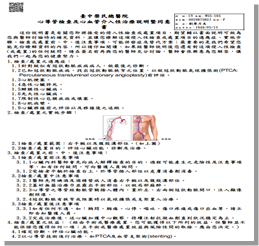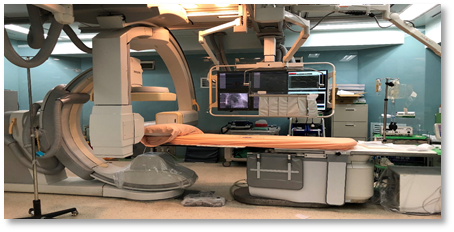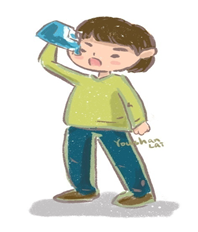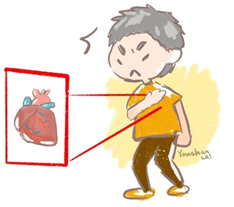[Learning Points]
- The majority (90%) of them result from renal artery atherosclerosis. Long-term renal artery stenosis can cause hypertension or deterioration of renal function gradually (so-called renal hypertension).
- Preparation for balloon dilatation / stent placement, including The doctor will explain the details of the procedure, possible risks, success rate, and you will be asked to complete a consent form etc.
Patients with renal artery stenosis are caused by a variety of factors. The majority (90%) of them result from renal artery atherosclerosis. Long-term renal artery stenosis can cause hypertension or deterioration of renal function gradually (so-called renal hypertension). In addition to medical treatment, renal artery balloon dilatation and stent placement are effective and widely accepted nowadays.
To treat hypertension and renal failure, which are caused by renal artery stenosis.
|
The doctor will explains the details of procedure, possible risks, success rate and you will be asked to complete a consent form. |
|
|
|
You will take a Chest X-ray, electrocardiogram, give a shot for collecting blood sampling, set up an intravenous line, and collect urine sample |
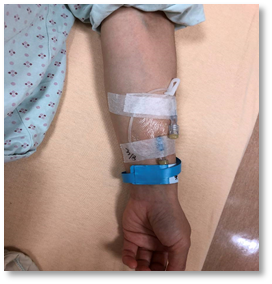 |
|
|
The staff will make a mark over dorsalis pedis artery for further assessment of adequate perfusion. |
 |
|
|
If the procedure is in the morning, you should not eat or drink after midnight; if the procedure is in the afternoon, you should not eat or drink after breakfast |
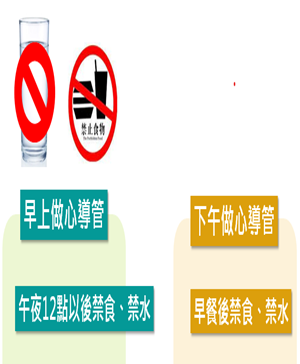 |
|
|
Before the procedure, the staff will give you a shot of anti-histamine for preventing allergy. You should take off your underwear; remove your glasses, removable dentures, accessories, and watches. |
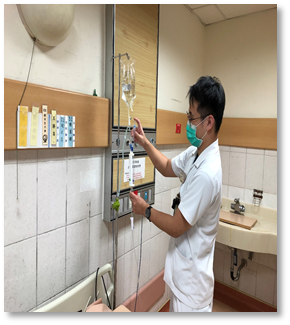 |
|
|
During the procedure, family members or relatives must accompany to wait outside the cardiac catheterization room. |
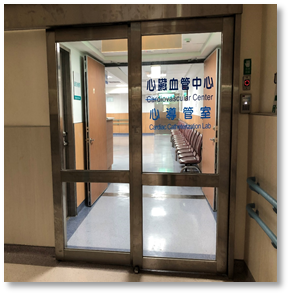 |
IV. The procedure of balloon dilatation/ stenting
patient lay down in supine position on the examination table → Local anesthesia around groin area → Insert a arterial sheath into femoral artery under the guidance of fluoroscopy → a guiding catheter will be selectively engaged to the renal artery→the doctor will perform renal artery angiogram to show the sites of stenosis → place the balloon catheter at stenotic site and dilate the balloon → stenting according the reference vessel size → wound dressing or use of self-paid vascular closure device for the puncture site of femoral artery.
|
examination table |
- The staff will closely observe your rate of pulse, respiration and blood pressure, measuring four times every 15 minutes, four times every 30 minutes, and twice every 1 hour. Absolute bed rest is required for 6 hours, and the puncture site is pressurized with a 2 kg sand bag. When lying down, it is forbidden to flex the knee joint and hip joint, but the toe joint on the puncture side can be moved. If you are a high risk of bleeding tendency, continuous bleeding or local bleeding after removal of the catheter (heat at the puncture site, wet and sticky feeling) etc., the doctor will extend the manual pressure for 15-30 minutes, and extend the pressure time until the puncture no bleeding at the site.
- After lying flat for 6 hours, the head of the bed can be raised 30 to 60 degrees. Activity for 2 hours, make sure there is no discomfort, and gradually get out of bed activities, and watch for dizziness.
- If there is a wound suture, the doctor will consider the individual situation and inform the sand bag compression time, you can get out of bed time, and then gradually get out of bed.
- For 24 hours, Do not get out of bed to take a shower (but you can take a bath in bed) and vigorous exercise, such as running or squatting up.
- If you experience coldness, numbness, or tingling in the limbs, please immediately notify the staff.
- If you have no water restrictions, drinking more water to eliminate the contrast from the body.
|
Do Not do knee and hip flexion when lying down. |
 |
|
take a bath |
running |
Drink more water |
|
Symptoms |
Deal with problems |
|
Vasovagal reaction (yawn repeatedly, dizziness, chest tightness, nausea, sweating, and even confusion).
  Dizziness Nausea
|
1. Inform staff by nursing call. 2. Bed rest and lower the head of the bed. 3. Intravenous fluid supply. |
|
Delayed bleeding: Still oozing or bleeding from the puncture site after 6-hour compression by sand bag.
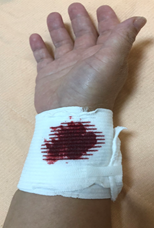 |
1. Hand compression the puncture site. 2. Inform staff by nursing call. |
|
Contrast allergic reactions (fever, nausea, redness of the skin)
|
Inform staff by nursing call. |
|
Chest pain
|
Please inform staff immediately. |
8. Post-procedural care at home
- There is no need to change dressing and keep the dressing away from water for one day. Remove the dressing the next day after discharge.
|
Cover with 1x1 gauze and sterile transparent dressing. |
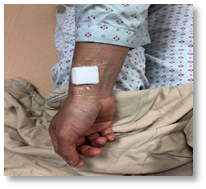 |
- If there is any pain, swelling, bleeding or any abnormality over the puncture wound, visit OPD or emergency immediately.
- If you have any opinions concerning medical services, you can call 04-23592525, extension 6055.
VI. Conclusion
Renal artery stenosis is one of the important causes of secondary hypertension, renal insufficiency, acute pulmonary edema or heart failure. Percutaneous renal artery balloon dilatation/stent placement is an effective and safe treatment.
VII. References
- 李和惠、方妙君(2021).心臟血管系統疾病病人之護理.胡月娟總校閱,內外科護理學(第六版,416-418).華杏。
- 吳泓彥、簡國龍(2019).高血壓與慢性腎臟病治療新進展.內科學誌 30(2),79-85。https://doi.org/10.6314/JIMT.201904_30(2).04
- Guerreiro, H., Avanesov, M., Dinnies, S., Sehner, S., Schön, G., Wenzel, U., Adam, G., Ittrich, H., & Regier, M. (2021). Efficiency of percutaneous stent angioplasty in renal artery stenosis - 15 Years of experience at a single center. Rofo, 193(3), 298-304. https://doi.org/10.1055/a-1236-4195
- 位置
-
- 資料夾名稱
- English
- 上傳者
- 王勝昌
- 單位
- 中榮護理衛教
- 英文名稱
- Before and after renal artery balloon angioplasty / stent placement care
- 分類
- 治療
- 科別
- 心臟內科
- 癌症照護
- 否
- 建立
- 2024-02-24 14:51:04
- 制訂日期
- 2016-11-05
- 最近修訂
- 2024-03-19 11:52:00
